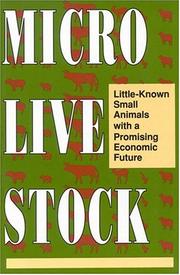| Listing 1 - 2 of 2 |
Sort by
|
Book
ISBN: 146143999X 9786613936066 1461440009 1283623617 Year: 2012 Publisher: New York : Springer,
Abstract | Keywords | Export | Availability | Bookmark
 Loading...
Loading...Choose an application
- Reference Manager
- EndNote
- RefWorks (Direct export to RefWorks)
Capybaras are not merely unusual, they are extraordinary. It is widely known that they are the largest living rodent (c. 50kg), but it is less well known that their biology is exceptional in many other regards, as documented in this book, Capybara: Biology, Use and Conservation of an Exceptional Neotropical Species. With a suit of adaptations to a semi-aquatic lifestyle, and a remarkable social system, the capybara is the South American ecological equivalent of the medium-sized ungulates of Africa. Their size, adaptations and habitat make them fascinating in their own right, and a revealing model for studies of the evolution of animal societies. Furthermore, from prehistory to the present day they have been hunted for their meat and skins, and nowadays they are both farmed and harvested, which makes them an illuminating case study for discussions of sustainable use. This blend of attributes makes the capybara a focus of specialist interest and a source of general principles, and these two ends of the readership spectrum are both encompassed by the extraordinary international team of 36 authors that have contributed the 24 inter-disciplinary chapters of this book. Written in an accessible style that will satisfy generalists, practitioners and specialists alike, this book represents the compendious ‘one-stop-shop’ that will be the benchmark publication on capybaras and on neotropical wildlife management for years to come.
Capybara. --- Rodents. --- Rodentia --- Capibara --- Capivara --- Capybaras --- Carpincho --- Hydrochaeris hydrochaeris --- Hydrochaeris isthmius --- Hydrochaerus hydrochaeris --- Hydrochoerus capybara --- Life sciences. --- Animal ecology. --- Conservation biology. --- Ecology. --- Wildlife. --- Fish. --- Life Sciences. --- Conservation Biology/Ecology. --- Animal Ecology. --- Fish & Wildlife Biology & Management. --- Mammals --- Hydrochaeris

ISBN: 030904295X 9786610212392 128021239X 0309568536 Year: 1991 Publisher: Washington, D.C. National Academy Press
Abstract | Keywords | Export | Availability | Bookmark
 Loading...
Loading...Choose an application
- Reference Manager
- EndNote
- RefWorks (Direct export to RefWorks)
Small animal culture. --- Livestock --- Livestock breeds --- Zoology, Economic --- 636.9 --- 636.5 --- 636.3 --- $?$92/11 --- Animals, Injurious and beneficial --- Animals, Useful and harmful --- Economic zoology --- Injurious and beneficial animals --- Animals and civilization --- Biology, Economic --- Pests --- Zoology, Medical --- Stock breeds --- Animal breeds --- Animal husbandry --- Farm animals --- Live stock --- Stock (Animals) --- Stock and stock-breeding --- Agriculture --- Animal culture --- Animal industry --- Domestic animals --- Food animals --- Herders --- Range management --- Rangelands --- Breeds --- animal husbandry --- small ruminants --- poultry --- ducks --- Guinea fowl --- Lizards --- Antilope --- Antelopes --- Tropical zones --- Rodents --- Domestication --- Agoutis --- Thryonomys --- Rodentia --- Central America --- South America --- Africa --- Asia --- Livestock. --- Livestock breeds. --- Zoology, Economic. --- Economic aspects --- Small animal culture --- Zoology [Economic ] --- Antelopes. --- Animal Husbandry. --- Rabbits. --- Animal Husbandry --- Rabbits --- Bees --- Deer --- Poultry --- Viscacha --- Hutia --- Capromys pilorides --- Myocastor coypus --- Hydrochoerus --- Dasyprocta --- Microbetail
| Listing 1 - 2 of 2 |
Sort by
|

 Search
Search Feedback
Feedback About UniCat
About UniCat  Help
Help News
News